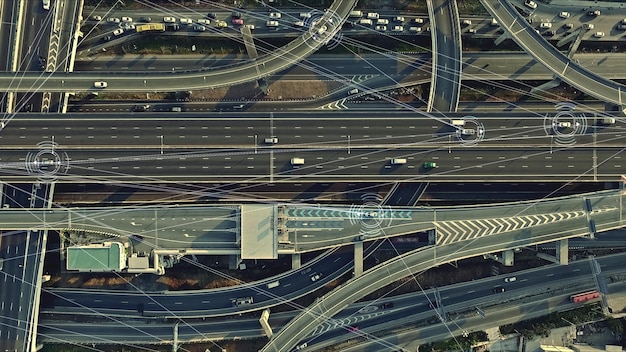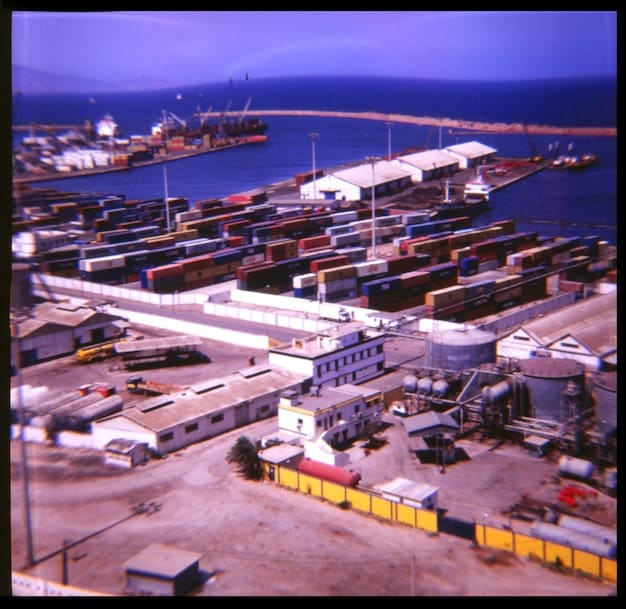Infrastructure Bill’s $550B Reshapes US Industries

The Infrastructure Bill’s $550 billion investment is set to profoundly reshape key industries across the United States, fostering significant growth in sectors ranging from transportation and energy to digital infrastructure and manufacturing, while prioritizing sustainability and resilience.
The recent federal infrastructure bill, a landmark piece of legislation, allocates a staggering $550 billion in new federal investments towards revitalizing America’s foundational systems. This isn’t just about fixing old bridges; it’s an expansive initiative poised to send ripple effects across diverse sectors, fundamentally altering economic landscapes and creating new frontiers for industries and businesses nationwide. Understanding the specific mechanisms and targets of this investment is crucial for stakeholders positioning themselves for the coming wave of transformation.
Unpacking the Bill: Core Investments and Their Immediate Targets
The Infrastructure Investment and Jobs Act (IIJA) represents the largest long-term investment in American infrastructure in generations. Its core tenets are designed to modernize critical systems, enhancing efficiency, safety, and resilience across the nation. This significant capital injection is not evenly distributed but strategically channeled into areas deemed most vital for future economic competitiveness and quality of life.
At its heart, the bill targets foundational elements that underpin the nation’s commerce and connectivity. From sprawling transportation networks to essential utility upgrades, the investments are broad yet focused, addressing longstanding deficiencies while preparing for emerging needs. The immediate beneficiaries are often public entities, but the flow of funds quickly translates into substantial opportunities for private sector companies engaged in project execution, material supply, and technological innovation.
Key Investment Pillars
The $550 billion is distributed across several critical pillars, each with specific aims and projected impacts.
- Transportation Networks: A significant portion is dedicated to roads, bridges, and public transit, aiming to alleviate congestion, improve safety, and enhance freight movement. This includes substantial funding for repair, maintenance, and new construction.
- Water Infrastructure: Investments target aging water pipes, lead service line replacement, and wastewater treatment, ensuring cleaner and safer drinking water and improved public health outcomes.
- Broadband Expansion: Acknowledging the digital divide, the bill commits substantial funds to expand high-speed internet access to unserved and underserved communities, fostering economic equity and educational opportunities.
- Power Grid Modernization: Funding is allocated to upgrade the electric grid, making it more resilient to extreme weather events, integrating renewable energy sources, and supporting the transition to a cleaner energy future.
Projected Short-Term Economic Boost
Beyond the long-term structural improvements, the immediate infusion of capital is expected to generate a considerable economic stimulus. This will manifest through job creation, increased demand for construction materials, and a surge in related service industries. Local economies, particularly those with existing infrastructure deficits, stand to benefit significantly from direct investments and the multiplying effect of increased economic activity.
The short-term impact is not just about job numbers; it’s also about empowering communities. Small businesses, minority-owned firms, and local contractors are poised to play a crucial role in the execution of these projects. The emphasis on domestic sourcing and employment further amplifies the internal economic benefits, circulating wealth within the U.S. economy.
Ultimately, the initial phase of the Infrastructure Bill’s implementation will be characterized by a ramp-up in project planning, procurement, and execution across various governmental levels. Businesses that are agile and prepared to engage with federal, state, and local agencies will be best positioned to capture these early opportunities.
Transportation and Logistics: Reshaping Mobility and Supply Chains
The infrastructure bill’s substantial allocation to transportation is poised to fundamentally alter how goods and people move across the country. With significant investments in roads, bridges, public transit, and even ports, the traditional bottlenecks in the nation’s supply chains are targeted for comprehensive overhaul. This will not only improve efficiency but also enhance the resilience of critical networks, a lesson sharply learned during recent global disruptions.
Modernizing America’s aging transportation infrastructure is a multifaceted undertaking. The bill dedicates billions to repairing and rebuilding highways and bridges that are past their prime. This investment is crucial for safety and efficiency, reducing travel times and the wear and tear on vehicles. Furthermore, it aims to reduce carbon emissions and tackle climate change through initiatives supporting public transit and electric vehicle infrastructure.
Roads and Bridges: A Foundation for Commerce
The lion’s share of transportation funding is earmarked for surface transportation programs. This includes repairing and upgrading thousands of miles of roads and bridges, many of which are in dire need of attention. Improved road conditions mean lower maintenance costs for businesses that rely on ground transport and faster, more reliable delivery times for goods.
- Enhanced Connectivity: Modernized arterial roads and interstate connectors will facilitate smoother freight movement between production hubs and consumer markets.
- Safety Improvements: Investments in bridge repair and replacement will mitigate risks, reducing accidents and delays caused by structural deficiencies.
- Economic Gateways: Key corridors for commerce, including those serving ports and major industrial centers, will see significant upgrades, reducing congestion and speeding up transit.
These improvements directly translate into economic benefits. For the logistics sector, it means more predictable routes and reduced fuel consumption, leading to lower operating costs. For manufacturers, it ensures a more reliable flow of raw materials in and finished goods out, contributing to more efficient just-in-time inventory management.
Public Transit and Rail: Expanding Options and Reducing Emissions
Beyond road networks, the bill also makes substantial investments in public transportation and passenger rail. This includes funding for new rail projects, upgrades to existing transit systems, and maintenance backlogs. The aim is to provide more resilient, cleaner, and accessible travel options, especially in urban and suburban areas.
Improved public transit reduces reliance on individual vehicles, easing traffic congestion and lowering carbon footprints. For businesses, enhanced public transit networks mean broader access to diverse talent pools and reduced commuting stress for employees. The expansion of rail infrastructure will also offer alternative freight options, potentially easing pressure on congested roadways.
The effects ripple out to related industries; for example, the demand for construction materials, engineering services, and smart transportation technologies will surge. Companies involved in sensors, traffic management systems, and intelligent infrastructure development are positioned for significant growth as states and municipalities seek to implement the most advanced solutions.

Energy and Utilities: Powering a Resilient and Green Future
The infrastructure bill funnels substantial capital into modernizing America’s energy and utility grids, driven by dual goals: enhancing resilience against climate change impacts and accelerating the transition to clean energy. This monumental investment will reshape the power generation, transmission, and distribution sectors, creating a ripple effect across related industries and opening new avenues for innovation.
For decades, many parts of the U.S. electrical grid have operated on outdated technology, leaving them vulnerable to extreme weather events and cyber threats. The bill addresses these vulnerabilities directly, aiming to fortify the grid through comprehensive upgrades. Concurrently, it underscores a national commitment to decarbonization, promoting renewable energy sources and cleaner technologies. This dual focus means that both traditional utility providers and emerging green energy companies stand to gain significantly from these allocations.
Modernizing the Electric Grid: Resilience and Security
A significant portion of the bill is dedicated to making the national power grid smarter, more reliable, and better equipped to handle future demands. This includes investments in advanced grid technologies, such as smart meters, energy storage solutions, and microgrids, which enhance grid stability and responsiveness. The goal is to minimize power outages, improve energy efficiency, and better integrate diverse power sources.
- Enhanced Grid Resiliency: Funding will support hardening critical infrastructure against natural disasters, reducing the frequency and duration of power disruptions.
- Cybersecurity Upgrades: A focus on protecting energy infrastructure from digital threats is paramount, ensuring the continuous and secure operation of essential services.
- Interconnectivity and Efficiency: Investments in transmission lines will improve the transfer of power, particularly from renewable energy hubs to consumption centers, reducing energy waste.
These upgrades will create immense opportunities for companies specializing in electrical engineering, smart grid technology, cybersecurity solutions, and energy storage systems. Manufacturers of high-efficiency transformers, advanced sensors, and intelligent monitoring equipment will also see increased demand as utilities modernize their operations.
Clean Energy Transition: Supporting Renewables and EV Infrastructure
The bill is a powerful catalyst for the clean energy transition, providing incentives and funding for renewable energy projects and the necessary infrastructure. This includes significant allocations for electric vehicle (EV) charging networks, a crucial step towards reducing reliance on fossil fuels in transportation.
Utilities are actively exploring ways to expand their renewable energy portfolios, driven by both market forces and legislative mandates. The bill accelerates this shift by supporting research, development, and deployment of clean energy technologies, including solar, wind, geothermal, and hydropower.
The push for EV charging infrastructure is particularly transformative. The goal is to build a national network of 500,000 public EV chargers, addressing one of the major barriers to widespread EV adoption. This massive undertaking will boost the construction sector, stimulate manufacturing of charging equipment, and create new service opportunities for EV charging network operators and maintenance providers.
From large-scale wind farms to residential solar installations, the entire clean energy supply chain, including developers, manufacturers, installers, and project financiers, will experience significant tailwinds. The energy sector’s future under this bill will be defined by greater resilience, efficiency, and a pronounced shift towards sustainable practices.
Digital Infrastructure: Bridging the Broadband Divide and Beyond
In the 21st century, access to reliable and affordable high-speed internet is no longer a luxury but a fundamental necessity. The infrastructure bill recognizes this, dedicating significant resources to expanding broadband access, especially in unserved and underserved communities. This investment is not merely about connectivity; it’s about fostering economic equity, enhancing educational opportunities, and enabling digital transformation across all sectors.
Millions of Americans still lack adequate internet access, creating a profound digital divide that hinders economic development and social mobility. The bill directly targets this disparity, aiming to ensure that every household and business has access to the digital highways that underpin modern life. This comprehensive approach goes beyond simply laying fiber; it encompasses affordability initiatives and digital literacy programs, ensuring that the infrastructure is not only built but also utilized effectively.
Broadband Expansion: Connecting the Unconnected
The core of the digital infrastructure investment lies in deploying high-speed internet to rural and remote areas, as well as low-income urban communities. This involves significant federal grants and funding for states, local governments, and tribal lands to build out broadband networks. The emphasis is on future-proof infrastructure, primarily fiber-optic, capable of supporting bandwidth demands for decades to come.
- Rural Connectivity: The bill prioritizes reaching communities where private sector investment has historically lagged, ensuring equitable access to digital resources.
- Digital Inclusion: Beyond physical infrastructure, programs are designed to assist low-income households with internet affordability and provide digital literacy training.
- Economic Growth Engine: Widespread broadband access stimulates local economies, enables remote work, supports telehealth, and facilitates e-commerce for small businesses.
This initiative represents a boon for telecommunications companies, network equipment manufacturers, and civil engineering firms specializing in fiber deployment. The demand for fiber optic cables, networking hardware, and skilled labor for installation will skyrocket. Furthermore, the expansion creates new markets for internet service providers (ISPs) that can compete to offer affordable services in newly connected areas.
Beyond Broadband: Smart City Technologies and Data Centers
While broadband expansion is central, the digital infrastructure investments extend to broader applications that leverage high-speed connectivity. This includes funding for smart city initiatives, which utilize connected technologies to improve urban services, traffic management, and public safety. These projects require robust data infrastructure and advanced analytics capabilities.
The increased reliance on digital services and the deployment of IoT (Internet of Things) devices will also drive demand for data centers and cloud computing infrastructure. As more data is generated and processed at the edge, investments in resilient, localized data processing capabilities will become increasingly vital. This creates opportunities for data center operators, hardware manufacturers, and software development companies focused on data management and AI.
The digital transformation catalyzed by this bill will touch almost every sector. Education will benefit from enhanced remote learning capabilities, while healthcare will see expanded telehealth services. Agriculture can leverage precision farming technologies, and manufacturing can embrace industry 4.0 concepts like smart factories, all powered by a robust digital backbone. The long-term implications are profound, setting the stage for a more connected and technologically advanced nation.
Manufacturing and Construction: A Resurgence of Domestic Production
The Infrastructure Investment and Jobs Act is poised to ignite a significant resurgence in the U.S. manufacturing and construction sectors. The sheer scale of projects, from rebuilding roads to deploying broadband, will create an immense demand for domestically produced materials, equipment, and skilled labor. This “Buy American” emphasis embedded within the bill is designed to strengthen domestic supply chains, create jobs, and enhance national economic resilience.
For decades, the U.S. has experienced a decline in manufacturing capacity, partly due to outsourcing. This bill aims to reverse that trend, providing a powerful incentive for companies to produce goods and materials within the country. The construction sector, already a significant employer, will see an unprecedented surge in activity, requiring extensive collaboration between public and private entities.
Boosting Domestic Manufacturing and Supply Chains
A key provision of the bill is the “Buy American” clause, which mandates that materials and products used in federally funded infrastructure projects must be produced in the U.S. This includes everything from steel and concrete to wiring, pipes, and even components for EV chargers and renewable energy systems. This clause provides a substantial boost to American factories and their workforce.
- Increased Demand for Materials: Steel mills, cement producers, lumber factories, and other core material suppliers will experience a surge in orders.
- Component Manufacturing: Manufacturers of specialized equipment, such as traffic control systems, water filtration components, and electrical grid technology, will see heightened demand.
- Supply Chain Reshoring: The emphasis on domestic sourcing could encourage some companies to bring production back to the U.S., creating a more robust and secure supply chain.
This will translate into new investments in manufacturing facilities, technological upgrades, and job creation across various industrial sectors. Companies that can demonstrate compliance with “Buy American” provisions and possess the capacity to scale production will be particularly well-positioned. The bill, therefore, acts as a powerful industrial policy, strengthening the domestic manufacturing base.
A Boom for the Construction Sector
The direct impact on the construction industry will be immediate and extensive. Roads, bridges, ports, broadband networks, and water systems all require massive construction efforts. This will necessitate a robust expansion of the construction workforce, from project managers and engineers to skilled tradespeople like electricians, plumbers, and heavy equipment operators.
For construction companies, this means a pipeline of projects that will last for years, providing stability and growth opportunities. They will need to invest in new equipment, adopt advanced construction technologies, and focus on workforce development. The demand for related services, such as architectural design, civil engineering, project management, and environmental consulting, will also surge.
Local and state governments will be issuing a multitude of contracts, making it essential for construction firms to understand the federal procurement processes and to build relationships with public agencies. Innovation in construction methods, such as modular construction and advanced materials, could also gain traction as projects seek efficiency and speed. The interconnectedness of these sectors means that a strong manufacturing base will directly support the construction industry’s ability to deliver these ambitious infrastructure projects on time and within budget.
Environmental and Resiliency Industries: Adapting to Climate Change
Beyond traditional infrastructure, the bill places a significant emphasis on environmental protection, climate change adaptation, and enhancing the resilience of communities to extreme weather events. This focus creates a substantial new market for industries specializing in green technologies, environmental remediation, and disaster preparedness. It signifies a long-term shift towards building infrastructure that is not only robust but also sustainable and capable of withstanding the impacts of a changing climate.
The escalating frequency and intensity of natural disasters, from floods and wildfires to hurricanes, have underscored the vulnerability of existing infrastructure. The bill addresses this head-on, allocating funds for projects that fortify defenses, restore natural ecosystems, and develop innovative solutions to mitigate climate risks. This makes environmental and resiliency industries not just beneficiaries but critical partners in the implementation of the bill.
Climate Resiliency and Disaster Mitigation
A significant portion of the funding is directed towards making communities and infrastructure more resilient to climate impacts. This includes investments in flood control, coastal protection, drought mitigation, and wildfire management. These projects often involve nature-based solutions, such as restoring wetlands and forests, which provide natural buffers against extreme weather while also enhancing biodiversity.
- Flood Protection: Funding for levees, seawalls, and natural floodplains will protect communities and critical infrastructure from rising water levels.
- Wildfire Management: Investments in forest health, prescribed burns, and firebreak development will reduce the risk and severity of wildfires.
- Drought Preparedness: Funding for water recycling, desalination, and stormwater capture will enhance water security in arid regions.
This creates a robust market for environmental engineering firms, hydrological consultants, land management companies, and specialists in nature-based infrastructure. Companies that develop advanced materials resistant to extreme temperatures, corrosion, or seismic activity will also see increased demand. Furthermore, the insurance sector will be impacted as reduced climate risks could influence policy development and premiums.
Green Technologies and Emissions Reduction
The bill also champions clean technologies and initiatives aimed at reducing greenhouse gas emissions. This extends beyond the electric grid modernization to encompass investments in carbon capture, hydrogen production, and advanced recycling technologies. The goal is to establish a more sustainable industrial base and reduce the environmental footprint of existing infrastructure.
The emphasis on electric vehicles (EVs) and charging infrastructure, as mentioned previously, is also a key component of this green push. Additionally, brownfield remediation, superfund site cleanup, and addressing legacy pollution are priorities, creating significant opportunities for environmental consulting and cleanup companies. The development and deployment of sustainable building materials and practices will also gain traction across all infrastructure projects.
The long-term vision is to integrate environmental stewardship seamlessly into infrastructure development. This will require innovation across a spectrum of industries, from scientists developing new materials to engineers designing climate-adaptive structures. The environmental and resiliency sectors are poised for substantial growth, becoming integral to the nation’s infrastructure strategy.
Future Outlook and Strategic Implications for Businesses
The Infrastructure Investment and Jobs Act represents a generational opportunity, not just an immediate spending spree. Its long-term nature means that industries must adopt a strategic outlook, moving beyond short-term contracts to position themselves as enduring partners in the nation’s infrastructure evolution. Businesses that can adapt, innovate, and align with the bill’s overarching goals of sustainability, resilience, and equitable growth will be best poised for success.
The sheer volume of projects necessitates careful planning and resource allocation from both public agencies and private enterprises. The bill’s success hinges on effective collaboration, workforce development, and the adoption of cutting-edge technologies. For businesses, this means understanding the evolving regulatory landscape, identifying new market niches, and investing in future capabilities.
Workforce Development and Innovation
One of the most critical challenges and opportunities arising from the bill is workforce development. The demand for skilled labor across construction, engineering, manufacturing, and technical fields will be immense. Companies that invest in training programs, apprenticeships, and talent acquisition strategies will gain a significant competitive advantage. This also opens avenues for educational institutions and vocational schools to partner with industry.
Innovation will be a key differentiator. The bill encourages the adoption of new technologies—from artificial intelligence and drone technology in construction to advanced materials and digital twins in design and maintenance. Companies that embrace R&D and integrate smart solutions into their offerings will be better equipped to meet the evolving demands of modern infrastructure projects.
This strategic focus on human capital and technological advancement means that businesses can’t just react to tenders; they must proactively build capacity and expertise. Partnerships between established firms and tech startups could also flourish, combining traditional industry knowledge with disruptive innovation.
Public-Private Partnerships and Compliance
The scale of the infrastructure bill necessitates robust public-private partnerships (PPPs). Businesses capable of engaging effectively with federal, state, and local government agencies, understanding their specific needs and procurement processes, will unlock significant opportunities. Building trust and delivering on commitments will be paramount.
Furthermore, compliance with regulations, environmental standards, and the “Buy American” provisions will be non-negotiable. Companies must ensure their supply chains are transparent and that their practices align with the bill’s objectives, which include environmental sustainability and equitable labor practices. Those that can demonstrate a commitment to these values will enhance their reputation and win more contracts.
The long-term success of the Infrastructure Bill will depend on adaptive strategies from businesses. This includes anticipating future infrastructure needs, such as adapting to climate change impacts, integrating renewable energy, and managing increasingly complex digital networks. The industries that view this not just as a temporary boom but as a fundamental shift in national priorities will be the ones that thrive for decades to come. The strategic implications are clear: plan for the long haul, prioritize innovation, and invest in people.
| Key Area | Brief Impact Description |
|---|---|
| 🛣️ Transportation & Logistics | Modernizes roads, bridges, and transit, improving supply chain efficiency and reducing travel times. |
| ⚡ Energy & Utilities | Upgrades power grid resilience, supports renewable energy integration, and expands EV charging infrastructure. |
| 🌐 Digital Infrastructure | Expands high-speed broadband to unserved communities, fostering digital equity and economic growth. |
| 🏭 Manufacturing & Construction | Drives demand for domestic materials and labor, promoting job creation and supply chain reshoring. |

Frequently Asked Questions About the Infrastructure Bill’s Impact
▼
The primary beneficiaries are sectors directly involved in building and maintaining public works. This includes the construction industry, particularly firms specializing in civil engineering, road, bridge, and pipeline construction. Additionally, manufacturing companies producing materials like steel, concrete, and electrical components will see increased demand, alongside telecommunications firms expanding broadband networks.
▼
The bill is projected to create millions of jobs across various sectors. Direct job creation will occur in construction, engineering, and manufacturing. Indirectly, jobs will be generated in support industries such as logistics, material supply, and professional services. The emphasis on domestic sourcing ensures many of these jobs remain within the U.S. economy, boosting employment rates significantly.
▼
Yes, a considerable portion of the bill is dedicated to modernizing the electric grid, integrating renewable energy sources, and building out electric vehicle (EV) charging infrastructure. These investments support the transition away from fossil fuels, promote energy efficiency, and enhance grid resilience. Companies in solar, wind, battery storage, and EV charging technology will experience substantial growth opportunities.
▼
“Bridging the Broadband Divide” refers to the bill’s commitment to expanding high-speed internet access to rural, remote, and low-income urban areas that currently lack reliable connectivity. This initiative aims to ensure equitable access to digital resources for all Americans, fostering economic opportunity, improving education, and enabling telehealth services across the country. It’s a critical step towards digital equity.
▼
Businesses should strategically assess their capabilities related to infrastructure needs, such as construction, material supply, or digital services. Engaging with federal, state, and local government agencies to understand procurement processes is vital. Investing in workforce development, adopting new technologies, and ensuring compliance with “Buy American” provisions will position companies favorably to secure contracts and thrive as these investments roll out.
Conclusion
The Infrastructure Investment and Jobs Act is more than a spending package; it represents a foundational recalibration of the American economy. Its substantial $550 billion investment will not merely mend what is broken but will also forge new pathways for economic growth, technological advancement, and environmental resilience across a wide spectrum of industries. Businesses, large and small, that anticipate these shifts, invest wisely in capabilities and talent, and align with the bill’s strategic objectives are poised to thrive in this new landscape, ultimately contributing to a more robust, connected, and sustainable nation for decades to come.





